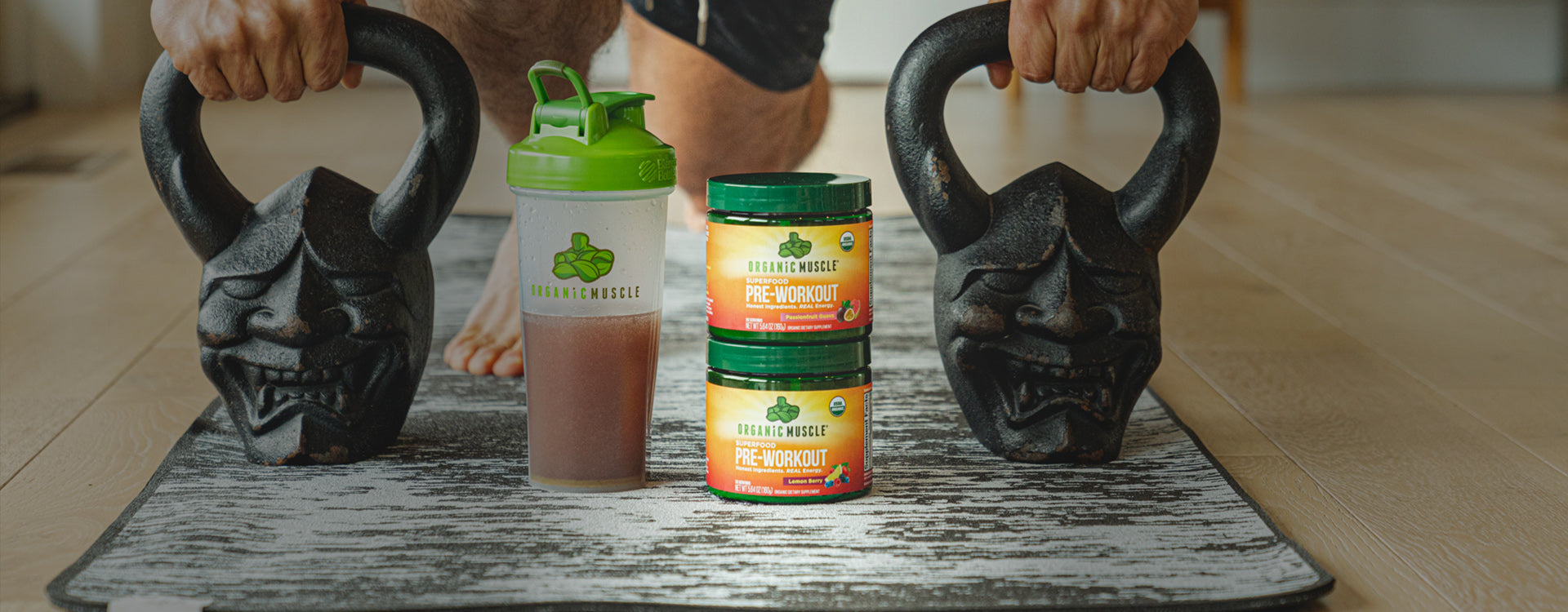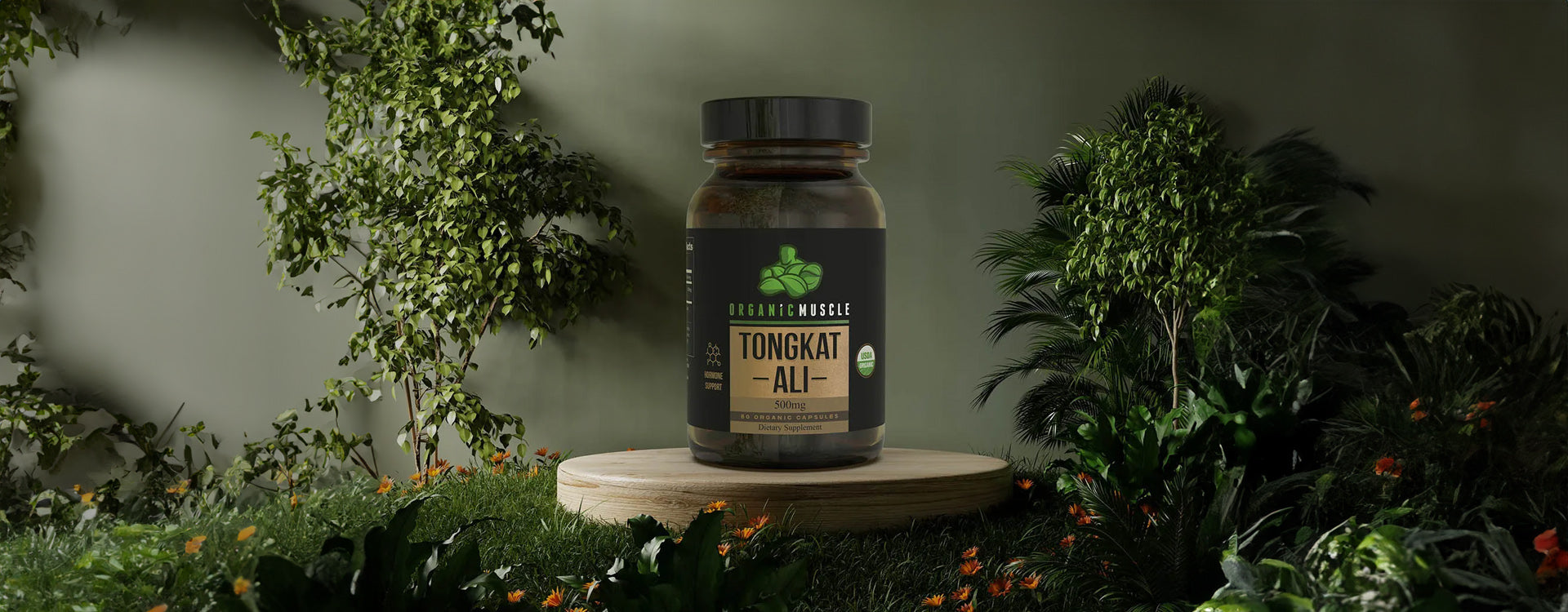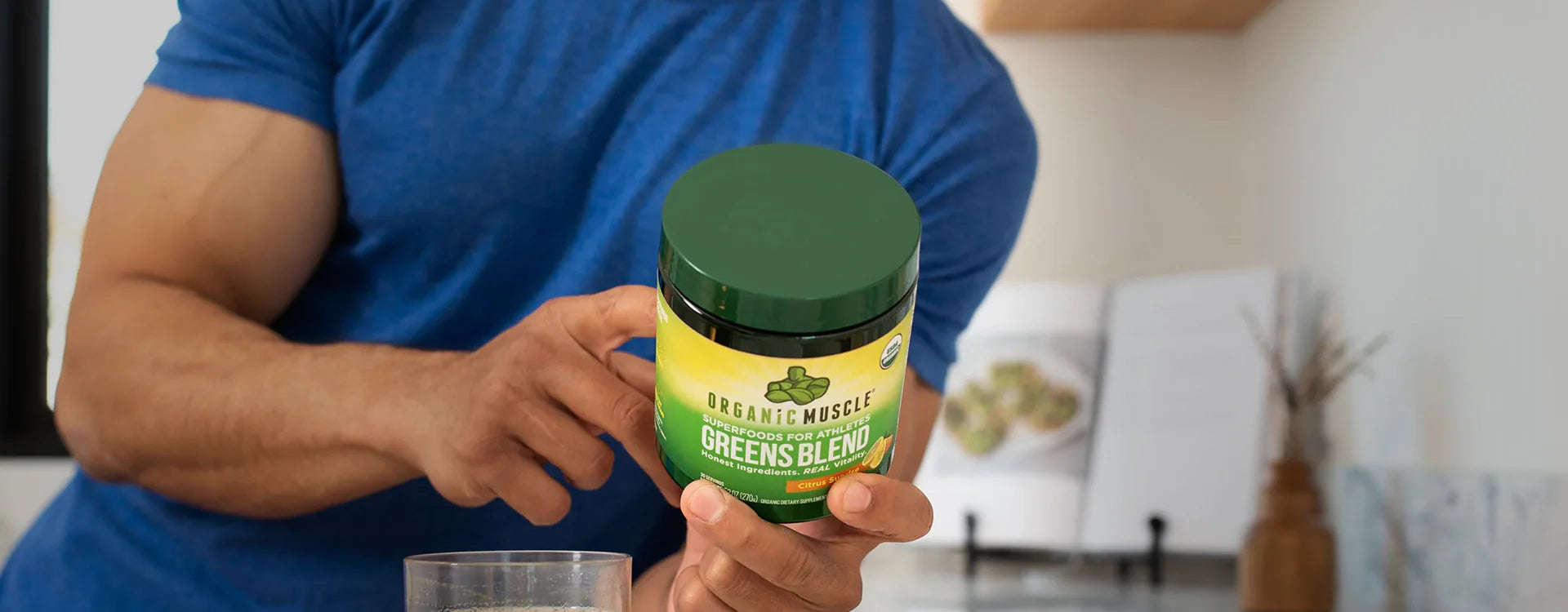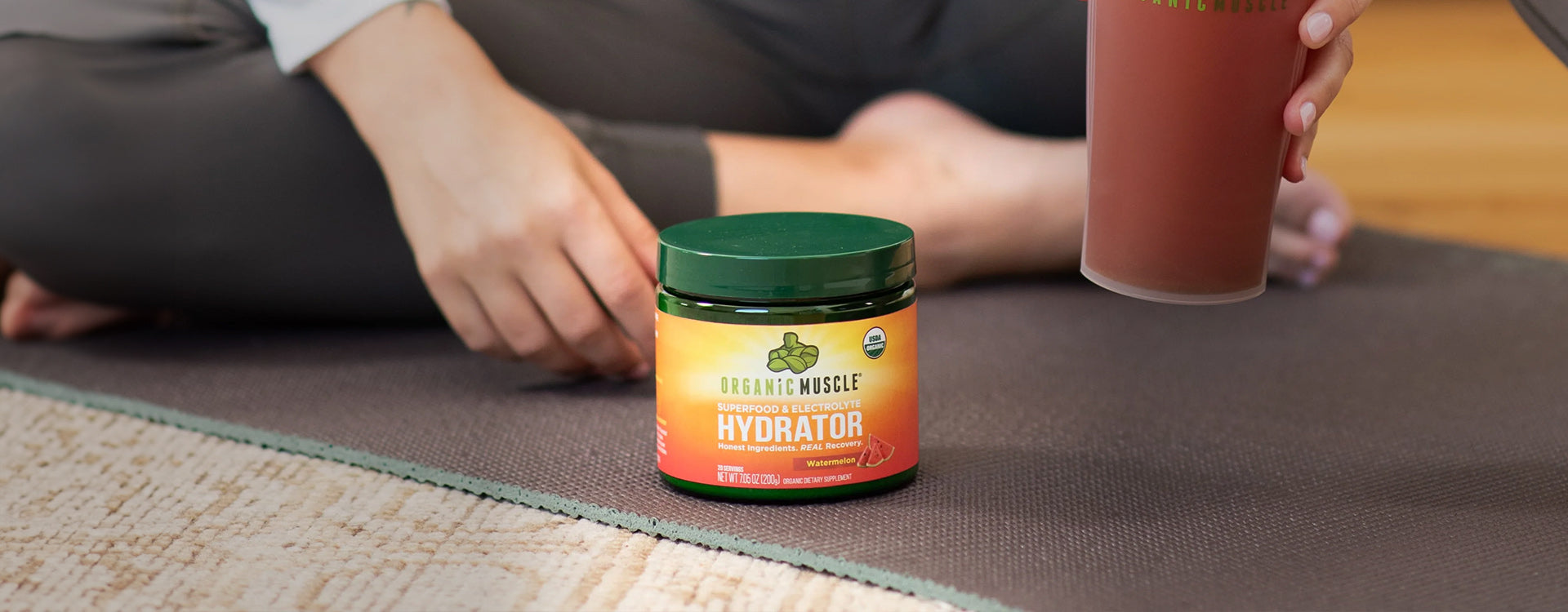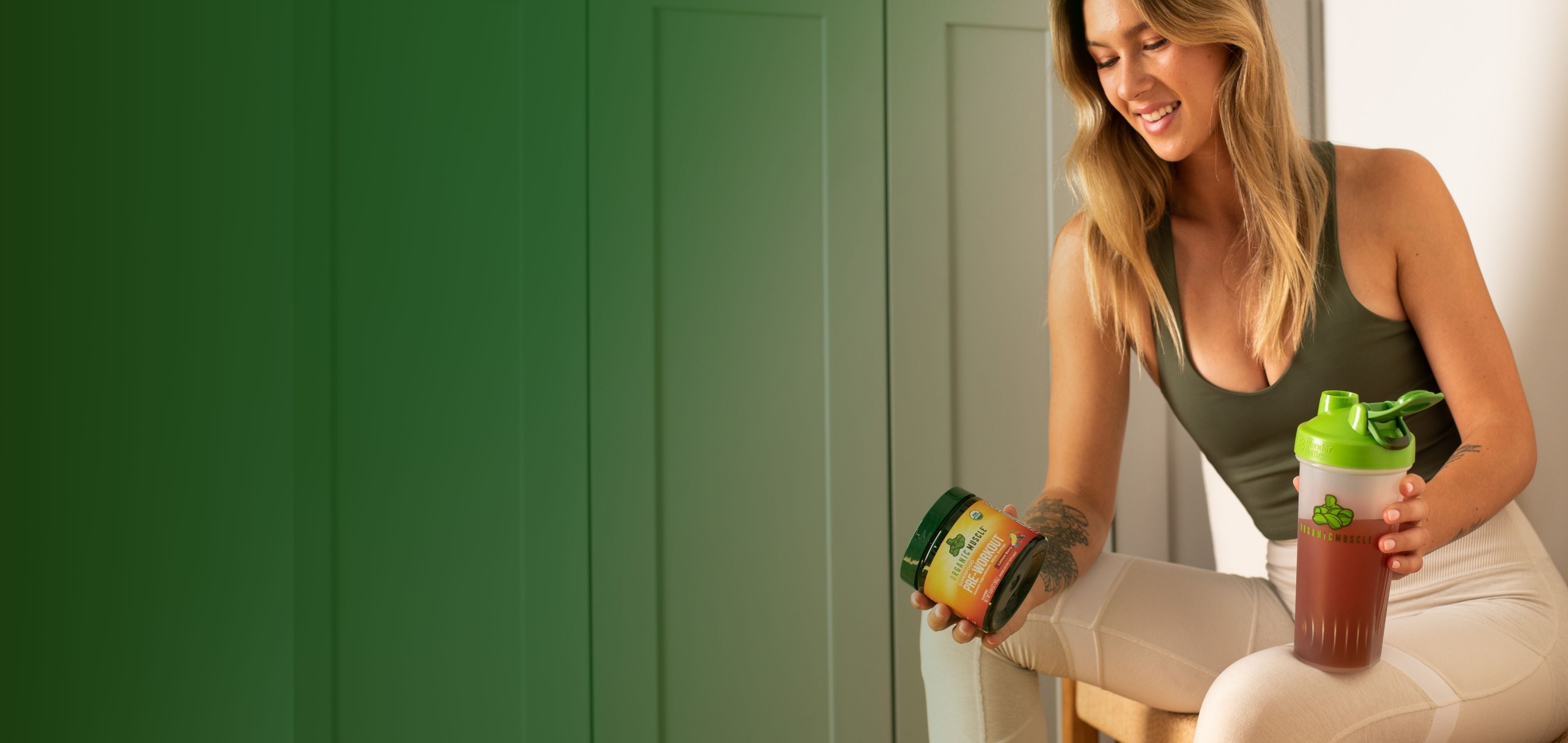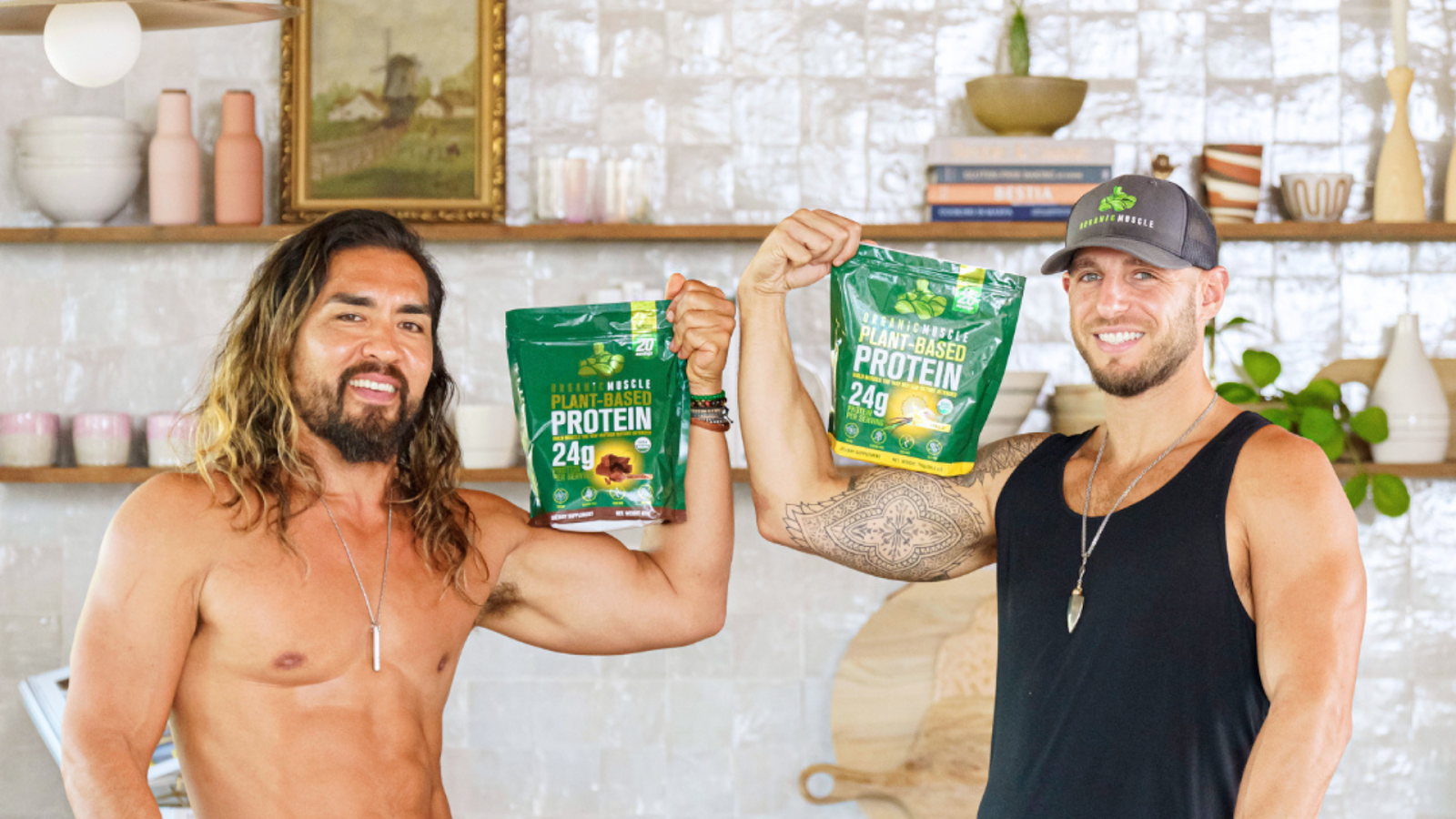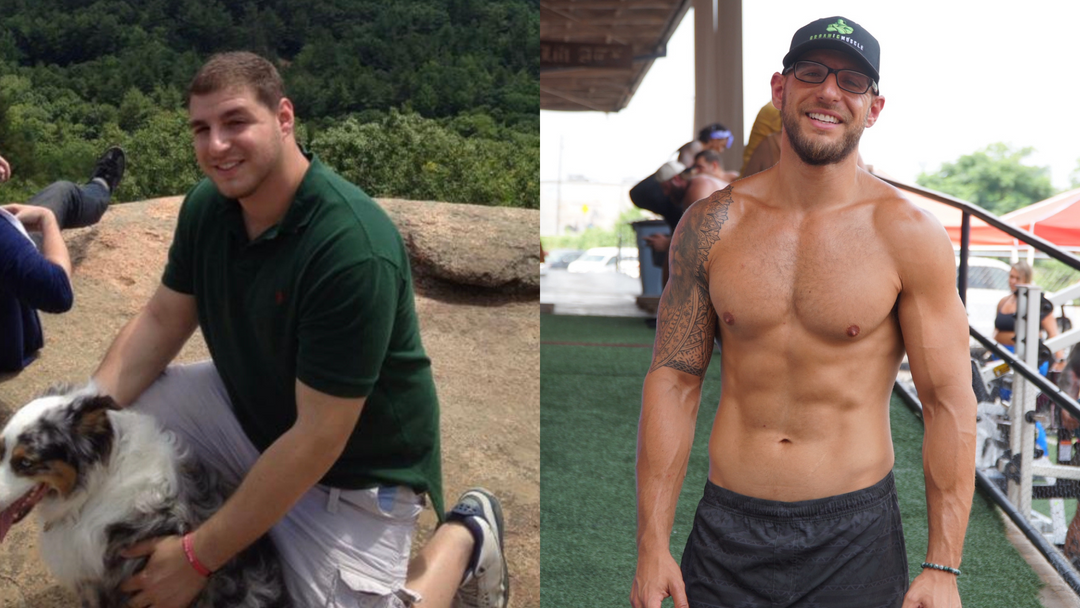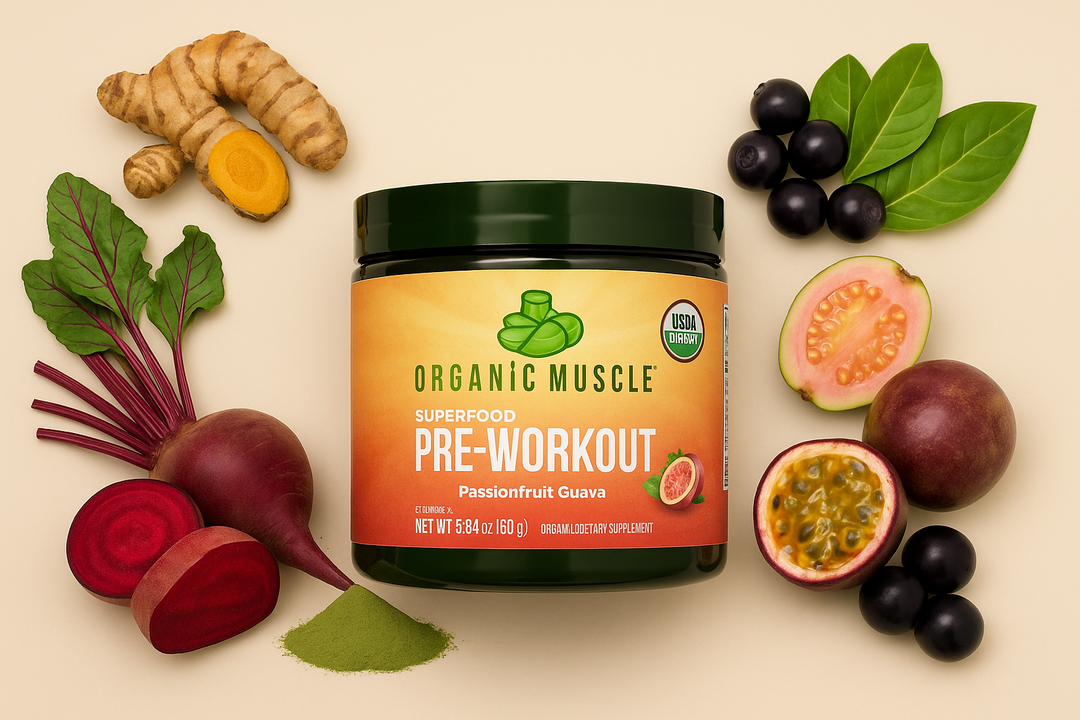Key Takeaways:
- Improved athletic performance and injury prevention: Strengthening your glutes enhances athletic capabilities and mitigates the risk of injuries by stabilizing the hips and improving posture.
- Comprehensive and effective workout routines: A mix of bodyweight and weighted exercises, a focus on proper form, and progressive overload ensure comprehensive glute development.
- Holistic wellness approach: Organic Muscle supplements support recovery and overall health, complementing your fitness regimen to promote physical strength and well-being.
Are you looking to build a stronger, rounder booty but unsure where to start? Your glutes play a key role in strength and aesthetics; with the right exercises, you can target these muscles for noticeable results. Think of your glutes as a foundation – with the right routine, you can build power and shape that support your overall fitness goals.
At Organic Muscle, we understand the importance of holistic wellness. We believe that a balanced approach to fitness, incorporating both effective workouts and nutritious supplementation, is the key to achieving and maintaining optimal health.
This guide is designed for fitness and health enthusiasts looking to elevate their lower body workouts. Whether you're a beginner aiming to establish a solid exercise routine or an experienced athlete seeking to intensify your training, these glute workouts are structured to help you achieve a stronger, rounder booty.
Why Strengthening Your Glutes Is Essential For Lower Body Fitness
Strengthening the glute muscles is fundamental to achieving a balanced fitness routine that supports lower body strength, stability, and functionality. The glutes, consisting of three primary muscles—gluteus maximus, gluteus medius, and gluteus minimus—play a crucial role in various athletic movements, including running, jumping, and walking. Focusing on targeted glute workouts helps sculpt a stronger, rounder booty and contributes significantly to your body's performance and health.
Enhanced Athletic Performance
The gluteal muscles are at the helm of power generation for lower body movements. Whether it's sprinting towards the finish line, climbing stairs, or performing high-intensity interval training (HIIT), strengthening your glutes can lead to notable improvements in athletic performance. Enhanced glute strength allows for more explosive movements, better endurance, and increased agility, enabling you to achieve your fitness goals more efficiently.
Improved Posture and Reduced Risk of Injury
Weak glutes can contribute to poor posture, lower back pain, and an increased risk of injuries, particularly during physical activities. Incorporating glute workouts into your fitness regime can help align your pelvis, improving posture and balance. Stronger glutes also play a vital role in stabilizing the hips, preventing common issues such as knee pain and IT band syndrome, and making your workout routine safer and more effective.
Better Functionality in Daily Life
The benefits of strong glutes extend beyond the gym. Glute strength is integral to everyday movements, from standing up from a seated position to lifting heavy objects. A stable and strong lower body ensures you can perform daily tasks more efficiently and with less strain on other muscles, which might otherwise compensate for weak glutes. This aspect of physical fitness is particularly important as it can contribute to greater independence and quality of life as one age.
How To Properly Warm Up Before Starting Your Glute Workouts
Warming up before your glute workouts is not just preliminary; it's imperative. A proper warm-up primes your muscles for the strenuous activities ahead, increasing blood flow and preventing injuries. In light of our commitment to holistic wellness, let's walk through a warm-up routine that readies your body, emphasizing safety and efficacy.
Start With Dynamic Stretching
Dynamic stretches involve active movements where joints and muscles go through a full range of motion. These can help to increase muscle temperature and mobility, crucial for effective glute workouts. Begin with leg swings (front to back and side to side), walking lunges, and high knees, each for 30 seconds to a minute. This approach enhances flexibility and activates the muscle groups you're about to engage deeply.
Activate Your Glutes
Activating your glutes before heavier exercises ensures they're the primary muscles working during your workout. Activation exercises like glute bridges, single-leg glute bridges, and donkey kicks, performed for 10-15 reps each, fire up these muscles. It’s about quality, not quantity; focus on the contraction of your glutes at the top of these movements.
Incorporate Mobility Work
Incorporating mobility exercises into your warm-up can prepare your body for glute workouts. Squat-to-stand and dynamic pigeon poses enhance the range of motion in your hips and lower body, which is crucial for performing glute exercises effectively. Performing 8-10 reps of each can make a noticeable difference in your mobility during the workout.
Gradually Increase the Intensity
Start with low-intensity exercises and gradually build up to higher-intensity movements to mimic the demands of your upcoming workout. This gradually increases your heart rate and blood flow to the muscles, reducing the risk of strains or injuries.
Best Bodyweight Glute Workouts For Beginners
Here are some of the best bodyweight glute workouts for beginners that combine simplicity with effectiveness.
Glute Bridges
Lie on your back with your knees bent and feet flat on the floor. Place your arms by your sides, and push through your heels to lift your hips towards the ceiling. Squeeze your glutes at the top, then lower your hips back down. This exercise targets the glutes and helps improve core stability.
Donkey Kicks
Begin on all fours, keeping your knees hip-width apart and your hands directly under your shoulders. Bracing your core, lift one leg behind you, keeping your knee bent at 90 degrees, and lift your foot towards the ceiling. Lower it back down without resting your knee on the ground. Repeat on each side to effectively engage your glutes and lower back.
Squats
Stand with your feet slightly wider than shoulder-width apart, toes pointing slightly outward. Keep your spine tall and core engaged, and lower your body as if sitting back into a chair until your thighs parallel the floor. Ensure your knees do not go past your toes. Push through your heels to return to the starting position. Squats are fantastic for your glutes, thighs, and core.
Lunges
Start standing, take a big step forward with one leg, and lower your body until both knees are bent at 90 degrees. Ensure your front knee is directly above your ankle, and your back knee doesn’t touch the floor. Push back up to the starting position. Lunges are great for building glutes and also help improve balance.
Side Leg Raises
Lie on your side with your legs extended, stacking your feet on each other. Prop your head up with your hand, or rest it on your arm. Lift your top leg towards the ceiling while keeping it straight, and lower it back down without letting it touch your bottom leg. This exercise targets the side glutes and hips.
Top Weighted Glute Exercises To Build Strength And Muscle
While bodyweight exercises are an excellent starting point, adding resistance through weights further challenges your muscles, promoting growth, strength, and the sculpted shape you aim for. Below, we outline some of the most effective weighted glute exercises to enhance your workout routine.
Barbell Hip Thrusts
Barbell hip thrusts are a powerful way to target the glutes. You drive your hips upwards by placing a weighted barbell over your hips and bracing your upper back against a bench, engaging your glutes and hamstrings. This movement offers significant strength gains and improves hip mobility and glute activation, which are essential for a well-rounded fitness routine.
Deadlifts
A classic strength-building exercise, deadlifts are exceptionally beneficial for the glutes, lower back, and hamstrings. Whether you prefer the conventional, sumo, or Romanian deadlift, incorporating this exercise into your regimen can significantly enhance posterior chain power. Focus on form to maximize benefits and minimize the risk of injury.
Weighted Lunges
Lunges are versatile exercises that target the glutes, quads, and core. Adding weights, be it dumbbells or a barbell, increases the intensity, further stimulating muscle growth. Weighted lunges can be performed in various ways—forward, backward, or even side lunges—each variation challenging the glutes differently.
Squats
No glute-building discussion is complete without mentioning squats. Whether using a barbell, kettlebell, or dumbbell, adding weight to your squats forces your muscles to work harder, promoting muscle growth and strength. Focus on depth and form to ensure your glutes are properly engaged throughout the movement.
Bulgarian Split Squats
This unilateral exercise is excellent for correcting imbalances and intensively targeting each glute. By elevating one foot on a bench and squatting down with the other leg, you're working your glutes and improving balance and coordination. Incorporating weights amplifies the challenge and the rewards.
Advanced Glute Workouts For A Stronger, Rounder Booty
As you progress in your fitness journey, it becomes essential to incorporate more challenging exercises to continue developing strength and shape in your glutes. Advanced glute workouts are designed not just to enhance the aesthetics of your booty but to improve overall athletic performance and reduce the risk of injury in daily activities. Here, we present a selection of advanced exercises to take your glute regimen to the next level.
Barbell Hip Thrusts
How to Perform:
- Sit on the ground with a bench behind you and a loaded barbell over your legs. Leaning against the bench so it hits just below your shoulder blades, plant your feet firmly on the ground, a little more than shoulder-width apart.
- Drive through your heels, extending your hips vertically. Ensure the barbell remains secure and your chin is tucked to your chest to maintain spinal alignment.
- Pause at the top, squeezing your glutes hard, then return to the starting position in a controlled motion.
This exercise focuses intensely on the glutes, stimulating growth and strength enhancement.
Bulgarian Split Squats
How to Perform:
- Stand about two feet in front of a bench or sturdy chair, facing away. Place one foot behind you on the bench.
- Descend into a squat, keeping the front foot flat on the ground and your chest upright. The knee of the rear leg should come close to touching the floor.
- Push through your front heel to rise back up to the starting position.
This unilateral exercise challenges your balance and activates the glute muscles of the front leg, promoting symmetry and strength.
Weighted Step-Ups
How to Perform:
- Holding dumbbells at your sides, position yourself in front of a bench or platform.
- Step up with one leg, pressing through your heel to lift your body up onto the platform.
- Bring the second leg to meet the first before stepping down and repeating on the opposite side.
Weighted step-ups target the glutes and thighs, further sculpting the lower body and adding power to your stride.
Deadlifts
How to Perform:
- Stand with your feet hip-width apart, a barbell in front of your shins. Hinge at your hips to bend over and grasp the bar using an overhand grip.
- Keeping your back neutral, lift the bar by straightening your legs and thrusting your hips forward. The bar should be close to your body throughout the movement.
- Lower the bar back to the ground in a controlled manner.
Deadlifts are excellent for developing posterior chain strength, encompassing the glutes, hamstrings, and lower back.
Cable Kickbacks
How to Perform:
- Attach an ankle cuff to a low cable pulley and then to one of your ankles.
- Facing the machine, brace yourself by holding onto the frame, keeping your torso fixed and slightly bent forward.
- Extend your cuffed leg back and up, focusing on using your glutes to perform the motion.
- Return to the starting position and repeat before switching legs.
Cable kickbacks isolate and target the glutes in a way few other exercises can, perfect for rounding off any advanced workout.
Common Mistakes That Prevent Your Glute Workouts From Being Effective
In the pursuit of a stronger, rounder booty, it's not just about the exercises you perform but how you perform them. Avoiding these common mistakes can significantly increase the effectiveness of your glute workouts, enabling you to see better results faster.
Overlooking Proper Form
One of the most significant barriers to effective glute training is neglecting proper form. Each exercise has a specific stance, alignment, and movement pattern designed to target the glutes efficiently while minimizing the risk of injury.
For instance, when performing squats, ensure your weight is in your heels and that you push your hips back and down as if sitting in a chair. This ensures maximum engagement of the glutes rather than overloading the quads and lower back.
Skipping Warm-Up
A thorough warm-up increases muscle blood flow and prepares your body for the workout ahead. Skipping this can lead to suboptimal performance and an increased risk of injury. Incorporating dynamic stretches and light, glute-activating exercises before your main workout can enhance muscle recruitment, allowing for more effective training sessions.
Neglecting Progressive Overload
To develop muscle and strength, you must continually challenge your muscles by increasing the intensity of your workouts over time. This is known as progressive overload. This might mean adding weight, increasing reps, or elevating the complexity of the exercises. Without this crucial principle, your muscles will adapt, and your progress will plateau.
Not Varying Your Routine
The glutes are composed of multiple muscles; to effectively work all of them, you need to incorporate various exercises into your routine. Relying solely on squats or any single exercise can lead to muscle imbalances and hinder your progress toward achieving a well-rounded booty. Including movements like bridges, lunges, and deadlifts helps target the glutes from different angles and ensures comprehensive development.
Overtraining the Glutes
While enthusiasm and dedication are commendable, overtraining can lead to muscle fatigue, soreness, and even injury, setting back your progress. The glutes need time to recover and grow stronger. Ensure you're not working them out intensely daily; 2-3 targeted glute sessions per week are generally sufficient for most people, depending on your overall fitness level and goals.
Ignoring Nutrition and Recovery
Finally, even the best workout plans can fall short without the right fuel and recovery. Your diet plays a crucial role in muscle repair and growth. Incorporate a balanced diet rich in proteins, complex carbohydrates, healthy fats, and the essential vitamins and minerals that support muscle recovery and growth.
How To Incorporate Glute Workouts Into Your Full-Body Training Routine
Incorporating glute workouts into your full-body training routine is essential for developing a balanced, strong, and aesthetically pleasing physique. Strong glutes can improve posture, enhance athletic performance, and reduce the risk of injury. Here's how to integrate glute workouts efficiently into your overall fitness plan, ensuring you're not just working hard but also smart.
Prioritize Compound Movements
Begin your routine with compound exercises that target multiple muscle groups, including the glutes. Moves like squats, deadlifts, and lunges are pillars for glute development. They also engage the core, hamstrings, and back, providing a strong foundation and maximizing your workout efficiency. By starting with these exercises, you ensure your glutes are activated from the very beginning.
Incorporate Isolation Exercises
After the compound movements, focus on isolation exercises targeting the glute muscles. Glute bridges, hip thrusts, and single-leg deadlifts allow focused work on the gluteal muscles. These exercises are crucial for addressing imbalances and honing in on the glutes to shape and strengthen them.
Frequency and Volume
Aim to include glute-focused exercises in your routine 2-3 times per week for optimal results. Adjust the volume based on your overall program and goals; however, a mix of heavy, lower-rep sets and lighter, higher-rep sets can effectively stimulate muscle growth and strength.
Integrate Unilateral Exercises
Incorporating unilateral (single-leg) exercises, such as split squats or single-leg hip thrusts, ensures that each side works independently, improving muscular balance and coordination. These exercises are excellent for correcting imbalances and enhancing your mind-muscle connection.
Progressive Overload
To continuously improve your strength and glute development, implement progressive overload by gradually increasing the weight, reps, or intensity of your exercises. This principle encourages consistent growth and adaptation in your glutes and overall physique.
Rest and Recovery
Rest is critical for muscle growth and recovery. Ensure you're giving your glutes ample time to recover between intense sessions. This might mean incorporating lighter training days or focusing on different muscle groups while your glutes recover.
Supplement for Success
Finally, complement your training routine with organic supplements from Organic Muscle. Our premium range of certified organic, non-GMO, vegan, and gluten-free supplements are designed to support your muscle recovery and growth, fueling your journey towards a stronger, rounder booty without compromising your health standards.
Following these guidelines, you can successfully integrate glute workouts into your full-body training routine, supporting your fitness and health goals. Remember, consistency is key to seeing progress, so stay dedicated and patient as you work towards enhancing your glute strength and aesthetics.
Final Thoughts
As we've journeyed through the best glute workouts, it becomes evident that strengthening your booty is not just about aesthetics; it's a commitment to enhancing your overall health and fitness. By incorporating these targeted exercises into your routine, you're working towards a stronger, rounder booty and fostering improved posture, better performance in physical activities, and reduced risk of injury.
At Organic Muscle, we understand that your fitness journey is intertwined with your quest for holistic wellness. That's why our comprehensive range of Certified Organic, Non-GMO, Vegan, Gluten-Free, Keto-Friendly, and Dairy-Free supplements is designed to complement your workout efforts and ensure you receive the nourishment your body needs to thrive both inside and out.
Remember, every rep counts towards building the strength and curves you desire. Stay encouraged, stay consistent, and most importantly, support your efforts with quality nutrition that aligns with your values and health goals. With the right workouts and Organic Muscle's unwavering commitment to purity and efficacy in every product, you're not just sculpting a beautiful physique but investing in longevity and well-being.
Read also:
- Pre-Workout Vs. Protein Powder: What’s The Difference?
- Does Pre-Workout Make You Gain Weight?
- Best Natural Bodybuilders To Follow
Frequently Asked Questions About The Best Glute Workouts For A Stronger, Rounder Booty
How often should I train my glutes for best results?
To achieve optimal results, it is recommended that you incorporate glute exercises into your routine 2 to 3 times a week. This frequency allows ample recovery time between sessions, crucial for muscle growth and strength improvement. Consistency and progressively increasing the intensity of your workouts will be key to seeing continuous improvements.
Is it necessary to use weights for glute exercises?
While bodyweight exercises can effectively target your glutes, incorporating weights can significantly enhance muscle strength and size more efficiently. Adding resistance in the form of dumbbells, kettlebells, or barbells to your routine challenges your muscles, promoting growth and strength. However, it’s essential to start with light weights and gradually increase as your strength improves to avoid injury.
What are the benefits of having strong glutes?
Beyond aesthetics, strong glutes contribute to better posture, improved athletic performance, and a reduced risk of injury, especially in the lower back and knees. They're essential for movements involving hip extension, rotation, and abduction, playing a critical role in daily activities like walking, running, and jumping.
How long does it take to see results from glute workouts?
Results from glute workouts can vary widely based on factors such as genetics, diet, exercise intensity, and consistency. Generally, with consistent training, dietary support, and sufficient recovery, noticeable improvements are possible within 4 to 12 weeks. It's important to set realistic expectations and understand that progress takes time and dedication.
Can glute workouts help reduce back pain?
Yes, strong glutes can play a significant role in reducing or preventing back pain. They support the pelvis and can alleviate pressure on the lower back, improving posture and reducing strain. Strengthening your glutes with your core muscles is often recommended as part of rehabilitation programs for lower back pain.
How can I prevent injuries when doing glute exercises?
To prevent injuries, start with a proper warm-up focusing on mobility and gradually increase the intensity of your workouts. Pay close attention to your form and technique, avoiding quickly overloading weights. Incorporating rest days into your fitness regimen is equally important to allow your muscles to recover and grow stronger. Listening to your body and not pushing through pain is crucial to prevent overuse injuries.
Sources:
- Buckthorpe, Matthew et al. “ASSESSING AND TREATING GLUTEUS MAXIMUS WEAKNESS - A CLINICAL COMMENTARY.” International journal of sports physical therapy vol. 14,4 (2019): 655-669.
- "3 Reasons Strong Glutes Are Important." BestCare, Methodist Health System, 16 May 2022, https://bestcare.org/news/3-reasons-strong-glutes-are-important.
|
Disclaimer: Organic Muscle products are not intended to treat, diagnose, mitigate, prevent, or cure disease. Organic Muscle products should not replace prescribed medications or the variety of foods important to a healthful diet. |
